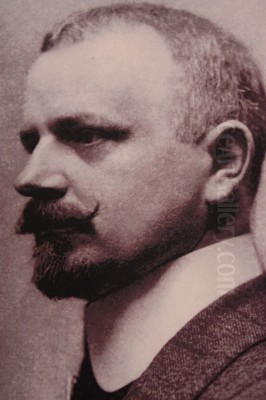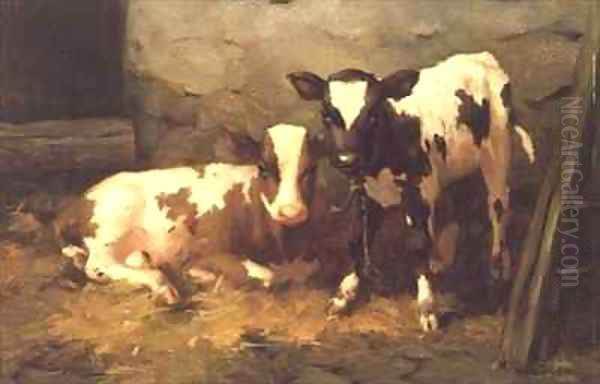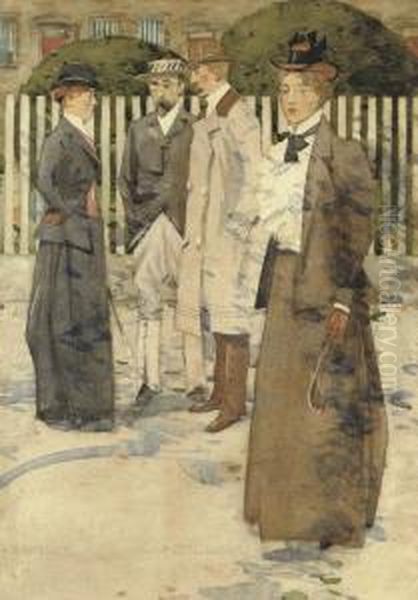
David Gauld stands as a significant figure in the landscape of Scottish art, particularly associated with the vibrant artistic milieu of late 19th and early 20th century Glasgow. Born in Glasgow in 1865, Gauld's life spanned a period of immense change and innovation in the art world. He passed away in East Kilbride on June 18, 1936, leaving behind a legacy marked by distinctive paintings, especially those capturing cattle bathed in sunlight, and notable contributions to stained glass design. His journey reflects a versatility and adaptability that characterized many artists of his generation.
Early Life and Artistic Formation
Gauld's entry into the art world was not through the traditional academic route. His initial training began with an apprenticeship in lithography, a craft demanding precision and graphic skill. This grounding in commercial art processes likely honed his sense of line and composition. From lithography, he transitioned into providing illustrations for newspapers, a field that required quick observation and the ability to capture contemporary life. The Glasgow Weekly Herald was one publication that featured his work, showcasing his early engagement with visual storytelling and social observation.
Alongside illustration, Gauld ventured into the realm of stained glass design. This early involvement in decorative arts would become a significant parallel strand throughout his career. It was from this practical, applied arts background that Gauld eventually turned his primary focus towards painting. Remarkably, he embarked on this path with relatively little formal art school training, developing his skills more through practice, observation, and association with fellow artists than through structured academic instruction. This self-driven approach perhaps contributed to the individuality of his later style.
The Glasgow School Context
David Gauld emerged as an artist during the ascendancy of the 'Glasgow School', a loose collective of artists often referred to as the 'Glasgow Boys'. This group, active primarily from the 1880s onwards, represented a reaction against the perceived conservatism of the Scottish art establishment, particularly the Royal Scottish Academy in Edinburgh. They sought new modes of expression, drawing inspiration from contemporary European art movements and direct observation of nature. Gauld became a core member and is considered one of the innovators within this influential group.

The Glasgow Boys, while diverse in their individual styles, shared common interests. Many, including Gauld, were influenced by the tonal harmonies and compositional elegance of James Abbott McNeill Whistler. French Realism, particularly the work of Jules Bastien-Lepage with its focus on rural life and naturalistic detail, was another crucial touchstone. The decorative potential of Japanese prints, with their flattened perspectives and bold outlines, also resonated with several members. Key figures associated with the movement alongside Gauld include James Guthrie, George Henry, E. A. Walton, John Lavery, Arthur Melville, E.A. Hornel, Joseph Crawhall II, W.Y. Macgregor, James Paterson, Alexander Roche, and Thomas Millie Dow.
Gauld's association placed him firmly within this progressive circle. He is sometimes considered part of a slightly later wave or grouping within the broader movement, alongside contemporaries like George Henry and James Guthrie. While not adhering to a strict manifesto, these artists shared a commitment to modernising Scottish art, often focusing on rural themes, naturalistic effects of light, and increasingly decorative compositions. Gauld's work embodies many of these characteristics.
Painting: Style, Subjects, and Influences
Painting became the central pillar of David Gauld's artistic output. He carved a distinct niche for himself, becoming particularly renowned for his depictions of cattle, often shown grazing peacefully in sun-dappled fields or silhouetted against the warm light of dusk. His series of works featuring calves, often simply titled Calves or Study of a Calf, are among his most characteristic and celebrated paintings. These works demonstrate his keen observational skills and his ability to capture the gentle nature of the animals with sensitivity and charm.
His subject matter frequently revolved around rural landscapes and pastoral life, reflecting the Glasgow School's broader interest in escaping urban industrialism for the perceived authenticity of the countryside. He had a particular fondness for capturing the atmospheric effects of twilight, rendering buildings and fields under the soft, evocative light of the setting sun. These landscapes often possess a quiet, lyrical quality, imbued with a sense of peace and harmony with nature.
Gauld's style evolved, integrating elements of Naturalism with the burgeoning aesthetics of Post-Impressionism and Symbolism. His handling of paint could be both descriptive and decorative. The influence of J. McNeil Whistler is apparent in the tonal subtlety and atmospheric concerns of some works. Another noted influence was the French painter Adolphe Monticelli, whose richly textured surfaces and jewel-like colour may have inspired Gauld's own handling of paint and decorative impulses. Furthermore, the impact of Japanese prints can be discerned in the flattened perspectives and strong linear patterns found in some of his compositions, particularly those with a more symbolic or decorative intent, such as the painting titled Music.

His approach blended careful observation of nature, especially the effects of light and atmosphere, with a growing interest in pattern, colour harmony, and decorative arrangement. This synthesis resulted in a distinctive personal style that contributed significantly to the character of the Glasgow School's output. His work was not merely representational; it often carried an idyllic or poetic undertone, celebrating the beauty of the Scottish countryside and its inhabitants.
Stained Glass Design: A Parallel Path
Concurrent with his painting career, David Gauld maintained a strong presence in the field of stained glass design, an area where Glasgow excelled during this period, partly through the influence of the Arts and Crafts movement. He collaborated significantly with Harrington Mann, another prominent Glasgow artist who also worked across painting and decorative arts. Together, they operated a studio and undertook numerous commissions, often for the firm J&W Guthrie, a leading name in Glasgow stained glass.
Gauld's work in stained glass is highly regarded and showcases a different facet of his artistic talent, one emphasizing line, colour, and narrative within an architectural context. One of his most prestigious commissions came in 1895 when the renowned architect John Burnet entrusted him with designing the entire scheme of stained glass windows for St. Andrew's Church in the town. This comprehensive project stands as a major achievement in his decorative work.
Another celebrated series of stained glass panels were those designed for the music room of a private residence belonging to the Guthries. These panels typically depicted elegant, elongated female figures playing various musical instruments, rendered in a style that reflects the influence of Art Nouveau and Symbolism. These music room windows are often cited as among his most outstanding accomplishments in the medium, admired for their graceful linearity and sophisticated colour harmonies.
Gauld and Mann also designed windows for numerous other churches, including St James' Parish Church (later St Patrick's Church) in Greenock. Their ecclesiastical work contributed significantly to the rich heritage of stained glass in Scottish churches. Beyond Scotland, commissions extended to locations in England and even as far as Australia, although sadly, some works, particularly in urban settings, have been lost due to subsequent redevelopment. His stained glass is generally characterized by fine draughtsmanship, rich colour, and often, a serene or spiritual quality suited to its context. A notable example of his work, simply titled "Window," was exhibited at the prestigious Glasgow International Exhibition of 1901, highlighting the recognition he received in this field.
Recognition, Roles, and Later Life
David Gauld's artistic contributions earned him considerable recognition both during his lifetime and posthumously. His paintings were exhibited not only within Scotland but also internationally, contributing to the growing reputation of the Glasgow School abroad. His work found its way into several public art collections, ensuring its accessibility to future generations. Galleries such as the Kelvingrove Art Gallery and Museum in Glasgow and the National Galleries of Scotland hold examples of his work.
Beyond his creative practice, Gauld played an active role in Glasgow's artistic community. He served as a member of the board of governors for the Glasgow School of Art, a testament to his standing among his peers and his commitment to art education in the city. He was also elected an Academician, likely of the Royal Scottish Academy (RSA), further signifying his acceptance and respect within the established art institutions, despite the Glasgow School's initial anti-establishment stance.
His association with publications like The Yellow Book, which featured his Study of a Calf, indicates his connection to the broader avant-garde movements of the fin-de-siècle. This publication, known for its association with Aestheticism and Decadence, included contributions from leading writers and artists of the day, placing Gauld within a significant cultural context.
David Gauld continued to paint and contribute to the art scene until his later years. He passed away in East Kilbride, near Glasgow, in 1936 at the age of 71.
Market Presence and Legacy
While detailed auction records were not fully captured in the initial source material, evidence confirms that David Gauld's works do appear on the art market. For instance, his painting Cheltenham Figures was offered at a Glasgow Art Club auction with a substantial estimate (£20,000-£30,000), indicating a recognized market value for his significant pieces. The presence of his work in public collections and its continued appearance at auction attest to his enduring appeal and historical importance.
David Gauld's legacy is multifaceted. As a painter, he is remembered for his sensitive and atmospheric depictions of the Scottish landscape and, most distinctively, his charming portrayals of cattle. His ability to capture light, particularly the golden hues of evening, remains a hallmark of his style. He successfully navigated the currents of Naturalism, Post-Impressionism, and Symbolism, creating a body of work that is both representative of the Glasgow School and uniquely his own.
Furthermore, his significant contributions to stained glass design ensure his place in the history of Scottish decorative arts. His collaborations, particularly with Harrington Mann, produced works of lasting beauty and craftsmanship that adorn churches and collections. His dual proficiency in painting and stained glass highlights the versatility that characterized many artists associated with the Arts and Crafts ethos prevalent during his time. David Gauld remains an important figure, representing the innovation, skill, and distinctive regional character of the Glasgow School.